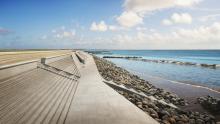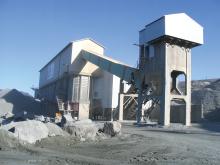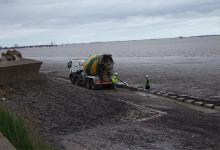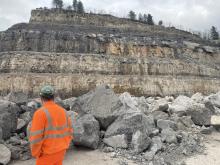
Procuring aggregate for coastal defence schemes is a complex task. ABE looks at the project to protect the Welsh seaside resort of Tywyn
The forces of the sea push engineering design to the limit in the bid to protect coastal communities from the risk of flooding and coastal erosion. Materials used for coastal defences are placed under high levels of stress and need careful selection.
Main contractor
Severe storms over the last 100 years had damaged the sea defences at Tywyn and action was needed to prevent further damage. The solution was to install rock armour and beach nourishment but selecting the right aggregates was fundamental to the success of the scheme.
"There were major factors we had to take into consideration when procuring the rock, crucially the location of Tywyn," explained Jones Bros senior materials manager Graham Gibson.
"Access by road is through the Snowdonia National Park and we wanted to keep any environmental impact to a minimum. At the same time, we wanted to maximise the supply of materials from local quarries, although we knew that, in the case of the rock armour, there would not be sufficient amounts available to complete our contract in the specified time." The rock armour specified for the scheme needed to comply with the requirements of EN 1338301 and was produced in four grades - 1-3 tonne, 3-6 tonne, 6-10 tonne and 10-15 tonne.
Jones' engineers carried out extensive appraisals of sources for the armour before the project began in order to ensure that both the physical properties of the rock and quarry production methodology complied with the requirements of the specification. A further consideration was the fact that the project was programmed between February and April during the winter months, though fortunately it proved less severe than the winter before.
Of the 60,000tonnes of rock armour required for the job, 30,000tonnes were sourced locally, mainly basalt, from quarries at Penmaenmawr in Conwy and Minffordd in Gwynedd. It was decided that the armour sourced from Penmaenmawr would be taken by road to Port Penrhyn at Bangor and then shipped to Tywyn. Armour sourced from Minffordd would be transported by road. The remaining 30,000tonnes of armour were sourced from granite quarries in the area around St Malo in northern France.
"This was most suitable as the quarries in that area of France tend to specialise in the production of block stone for architectural and monumental purposes," continued Gibson.
"The rock is extracted by mechanical means or using low explosives which means that the yield of large blocks is high, in contrast to the quarries in North Wales which are principally producing conventional aggregates where high explosives are used to fragment the rock into smaller pieces, and where the yield of large blocks is intentionally low." The rock armour from St Malo was shipped in two coastal vessels, carrying cargos of approximately 1700tonnes each. The ships would anchor at fixed points off the coast of Tywyn where the rock was transferred by on-board excavator, to the smaller side-tipping transfer vessels. The loaded side tipping vessels would then approach the beach location of the works at high tide and tip the rocks which would then be recovered and placed in position by plant on the beach, as the tide receded.
Beach nourishment materials were sourced from the maintenance dredging of Pwllheli harbour. Having been dredged and stockpiled they were re-screened by Jones and placed along Tywyn beach. "The great advantage to this is that the aggregates nourishing the coast at Tywyn have come just along the coast, so they are broadly from the same marine eco- system," added Gibson.
In total 9,000tonnes of beach nourishment materials were used - 6,000tonnes of reclaimed sand and 3,000tonnes of reclaimed shingle.
The project was completed on time during the autumn of 2010 and has since won awards, particularly for the way in which Jones engaged with the local community.
"We were delighted with the success of the scheme and we believe one of the main reasons for this was our decision to combine ship-born deliveries with road, ensuring a continuity of aggregate supply, crucial if you are working to a tight schedule," said Gibson.









